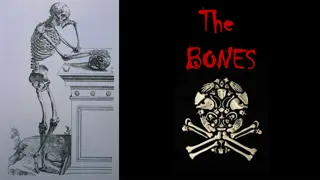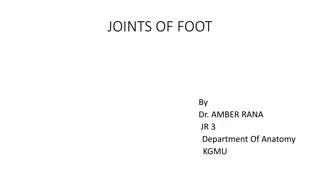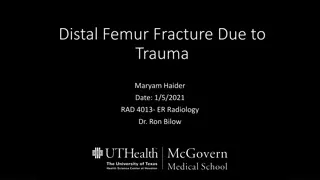Anatomy of Lower Limb Bones: Thigh (Femur and Patella) Overview
Explore the detailed anatomy of the bones in the lower limb, specifically focusing on the thigh bones - the femur and patella. Learn about the structure, function, and key features of these bones, including their articulations, surfaces, and attachments. Enhance your understanding of the classification and differentiation of lower limb bones from upper limb bones, aiding in the recognition of bone sides. Images included for visual reference.
Uploaded on Oct 03, 2024 | 1 Views
Download Presentation

Please find below an Image/Link to download the presentation.
The content on the website is provided AS IS for your information and personal use only. It may not be sold, licensed, or shared on other websites without obtaining consent from the author.If you encounter any issues during the download, it is possible that the publisher has removed the file from their server.
You are allowed to download the files provided on this website for personal or commercial use, subject to the condition that they are used lawfully. All files are the property of their respective owners.
The content on the website is provided AS IS for your information and personal use only. It may not be sold, licensed, or shared on other websites without obtaining consent from the author.
E N D
Presentation Transcript
BONES OF LOWER LIMB ANATOMY DEPARTMENT Dr. Mohammad Saeed Vohra vohra@ksu.edu.sa
OBJECTIVES At the end of the lecture the students should be able to: Classify the bones of the three regions of the lower limb (thigh, leg and foot). Differentiate the bones of the lower limb from the bones of the upper limb Memorize the main features of the Bones of the thigh (femur & patella) Bones of the leg (tibia & Fibula) Bones of the foot (tarsals, metatarsals and phalanges) Recognize the side of the bone
BONES OF THIGH (Femur and Patella) Femur: Articulates above with acetabulum of hip bone to form the hip joint Articulates below with tibia and patella to form the knee joint
BONES OF THIGH (Femur and Patella) Femur Consists of: Upper end Shaft Lower end
UPPER END OF FEMUR Head: It articulates with acetabulum of hip bone to form hip joint Has a depression in the center (fovea capitis), for the attachment of ligament of the head Obturator artery passes along this ligament to supply head of femur Neck: It connects head to the shaft
UPPER END OF FEMUR Greater and lesser trochanters Anteriorly connecting the 2 trochanters the inter-trochanteric line, where the iliofemoral ligament is attached Posteriorly the inter-trochanteric crest, on which is the quadrate tubercle
SHAFT OF FEMUR Gray245.png It has 3 borders Two rounded medial and lateral One thick posterior border or ridge called linea aspera It has 3 surfaces Anterior Medial Lateral
SHAFT OF FEMUR Posteriorly: below the greater trochanter is the gluteal tuberosity for attachment of gluteus maximus muscle The medial margin of linea aspera continues below as medial supracondylar ridge The lateral margin becomes continues below with the lateral supracondylar ridge A Triangular area, the popliteal surface lies at the lower end of shaft
LOWER END OF FEMUR Has lateral and medial condyles, separated anteriorly by articular patellar surface, and posteriorly by intercondylar notch or fossa The 2 condyles take part in the knee joint Above the condyles are the medial & lateral epicondyles
PATELLA It is a largest sesamoid bone (lying inside the Quadriceps tendon in front of knee joint) Its anterior surface is rough and subcutaneous Its posterior surface articulates with the condyles of the femur to form knee joint Its apex lies inferiorly and is connected to tuberosity of tibia by ligamentum patellae Its upper, lateral, and medial margins give attachment to Quadriceps femoris muscles
POSITION OF FEMUR (RIGHT OR LEFT) Head is directed upward & medially Shaft is smooth and convex anteriorly Shaft is rough and concave posteriorly
BONES OF LEG (TIBIA AND FIBULA) Tibia It is the medial bone of leg Fibula It is the lateral bone of leg Each of them has upper end shaft lower end
TIBIA Upper end has Two tibial condyles Medial condyle Is larger and articulate with medial condyle of femur. It has a groove on its posterior surface for semimembranosus muscle Lateral condyle Is smaller and articulates with lateral condyle of femur. It has facet on its lateral side for articulation with head of fibula to form proximal tibio-fibular joint Intercondylar area is rough and has intercondylar eminence
TIBIA Shaft has Tibial tuberosity Its upper smooth part gives attachment to ligamentum patellae. Its lower rough part is subcutaneous 3 borders Anterior boder is sharp and subcutaneous Medial border Lateral border also called interosseous border. 3surfaces Medial : subcutaneous. Lateral Posterior has oblique line, soleal line for attachment of soleus muscle
TIBIA Lower end Articulates with talus for formation of ankle joint. Its medial surface is subcutaneous (medial malleolus) Its lateral surface articulate with talus Fibular notch lies on its lateral surface of lower end to form distal tibiofibular joint
POSITION OF TIBIA (RIGHT OR LEFT) Upper end is larger than lower end Medial malleolus is directed downward and medially Shaft has sharp anterior border
FIBULA It is the slender lateral bone of the leg. It takes no part in articulation of knee joint. Its upper end has Head: articulates with lateral condyle of tibia Styloid process. Neck
FIBULA Shaft has Four borders & 4 surfaces Medial interoseous border gives attachment to interosseous membrane Lower end forms Lateral malleolus is subcutaneous Its medial surface is smooth for articulation with talus to form ankle joint
BONES OF FOOT Seven Tarsal bones start to ossify before birth and end ossification by 5th year in all tarsal bones. They are 1. Calcaneum 2. Talus 3. Navicular 4. Cuboid 5. Three cuneiform bones Only Talus articulates with tibia & fibula at ankle joint Calcaneum: the largest bone of foot, forming the heel
BONES OF FOOT Five Metatarsal bones They are numbered from medial to lateral. 1st metatarsal bone is large and lies medially. Each metatarsal bone has a base (proximal) a shaft and a head (distal) Fourteen phalanges Two phalanges for big toe (proximal & distal) Three phalanges for each of the lateral 4 toes (proximal, middle & distal) Each phalanx has base, shaft and a head.
Bottom line Skeleton of lower limb consists of: Femur: is the bone of thigh. Tibia: is the medial bone of the leg. Fibula: is the lateral bone of leg. Skeleton of foot: Tarsal bones (7 in number), calcaneum is the largest bone forming the heel. Metatarsal bones (5 in number). Phalanges (14 in number). The subcutaneous parts of bones in the lower limb are: Patella. Anterior border of the tibia Tibial tuberosity. Medial malleolus of tibia. Lateral malleolus of fibula. The foot is a complex structure. There are 26 bones in each foot alone. The foot is also well muscled and is supported by ligaments and tissue known as fascia. Support is of prime importance in the foot, as it bears the weight of the body and must adopt different configurations to permit locomotion.























